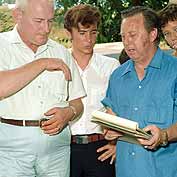|
In Woody Allen's Zelig, the title character has the knack of appearing in the background at major historical events. The bluegrass version of that movie might well be titled Bartenstein. The difference, of course, is that while the character Zelig is fictional, Fred Bartenstein has had a very real influence on the people, history, and growth of bluegrass music.
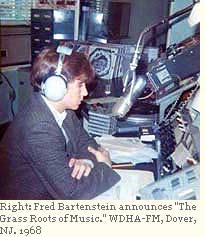
Among his many accomplishments, Fred’s been a bluegrass DJ since 1966; helped promoter Carlton Haney get the first bluegrass festivals off the ground; started one of the early bluegrass magazines, Muleskinner News; promoted and publicized countless concerts; co-founded a regional bluegrass association in Boston; serves as chair of an organization dedicated to the history of bluegrass music in southern Ohio; conducted the first market research on bluegrass; and wrote songs, played guitar, sang, produced, and recorded with the likes of Don Stover, Tex Logan, Vassar Clements, Del McCoury, Mac Wiseman, John Hartford, Joe Isaacs, Katie Laur, and Dorsey Harvey.
But perhaps Fred’s greatest accomplishment is how he’s been able to bring people together by building consensus within the bluegrass community and helping to open that community to others.
As president of Fred Bartenstein & Associates, LLC–an organizational development consulting firm in Yellow Springs, Ohio–he’s brought his professional expertise to the International Bluegrass Music Association and to the International Bluegrass Music Museum, both in their strategic planning retreats and IBMA’s Leadership Bluegrass program,. As a DJ, he presents a three-hour weekly history of bluegrass program, that’s webcast on bluegrasscountry.org and broadcast on stations in the US and Australia. And as a compiler of the history of bluegrass, he presented a paper titled "Bluegrass Generations" at the first Bluegrass Music Symposium at Western Kentucky University in September 2005.
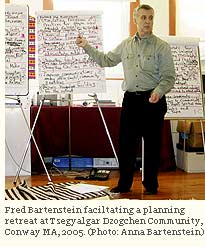
It’s hard to imagine a time when the IBMA–celebrating its 20th anniversary this year–was in danger of falling to factionalism. In 1997, Pete Wernick, then President, suggested to Executive Director Dan Hays that Fred would be a good person to lead a strategic planning retreat, something that was sorely needed to create a shared vision for the future of IBMA. Pete knew this was Fred’s specialty, but also knew that Fred had a rich and varied background in bluegrass and could speak the insider language of the diverse members of the board of directors.
Pete recalls, "We were pretty low on organizational skills and were spending way too much time in board meetings. We still made progress and a lot of great work was done, but even some pretty heavy-duty people in the industry were not used to being on a board of directors."
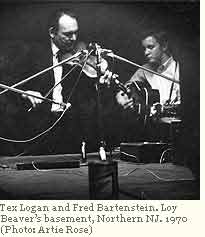
Pete had known Fred from his days in New York City, when Pete had a bluegrass radio show on WKCR at Columbia University. After the show, Fred would call in and they’d talk bluegrass. They eventually got together (Pete was surprised at how young Fred was), played for a time in a band, and stayed in touch through the years. Pete knew that Fred was the perfect person to bring into IBMA’s challenging situation.
After three days under Fred’s guidance, the board emerged from the retreat not only with a consensus among board members, but with an excitement that the IBMA was going to do great things. Pete Wernick: "I think Fred completely aced that situation. This was a group that was pretty contentious and could get off-topic. Fred would say, ‘All right, that was already said,’ and we’d move on. But he kept encouraging everyone to say everything they could think of–and everything they said, he was writing down on flip charts. We had tons of paper, and he said, ‘Okay, now pick five out of the fifteen points.’ He kept distilling the ideas in completely democratic fashion until everyone was basically in agreement. All that energy was now behind a freight train instead of going off in different directions."
Pete also credits Fred for encouraging him to start his Colorado-based banjo camps, among the first multi-day workshop retreats. Pete says that Fred wrote him shortly after the success of the first camp with a short note, "Hello muddah, hello faddah, how are things in Camp Granada?..."
Fred says, "When I facilitated that first strategic plan for IBMA, I was surprised. Back in the 70s bluegrass couldn’t organize itself, but I saw it happen at that first strategic meeting. And ever since I’ve been excited about what IBMA can do." Since the first IBMA strategic retreat, Fred has facilitated two more, in 2001 and 2004, as well as a similar retreat in 2003 for the International Bluegrass Music Museum in Owensboro.
And he’s contributed even more to a program started in 2000–Leadership Bluegrass. From an idea of Pete Kuykendall and originally organized by David Crow, the program has seen more than 150 people go through an intense three-day class covering all aspects of the bluegrass music industry.
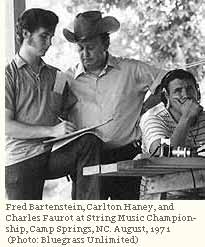
For anyone who has taken the class, it is hard to imagine it being as successful without the work of Fred Bartenstein. His presence is not intrusive, but he is there to make sure discussion stays on track, schedules run on time, and that no one is excluded from the process. Beyond this, however, he helps the Leadership Bluegrass committee prepare for each year, and suggests ideas for tweaking the class, ensuring the days are balanced and effective.
But while many good facilitators could do this, Fred brings the added perspective of someone who has been in the bluegrass business for 40 years. He knows the history and the personalities. As Dan Hays says, "There are three things that Fred brings to the table–a high level of understanding of the music and its history, a way about him of fostering consensus, and an ability to quickly grasp both the big picture and the details."
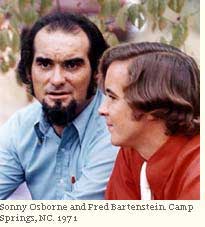 Born in 1950 in Lexington, Virginia, Fred recalls extended visits to his mother’s family in southwestern Virginia, where he would hear Red Smiley and the Bluegrass Cut-Ups in the morning on WDBJ-TV out of Roanoke. At six years old, on a visit to radio station WREL (the call letters stand for "Robert E. Lee") in Lexington, Virginia, he was asked what kind of music he liked. He replied "Mountain Music!" Born in 1950 in Lexington, Virginia, Fred recalls extended visits to his mother’s family in southwestern Virginia, where he would hear Red Smiley and the Bluegrass Cut-Ups in the morning on WDBJ-TV out of Roanoke. At six years old, on a visit to radio station WREL (the call letters stand for "Robert E. Lee") in Lexington, Virginia, he was asked what kind of music he liked. He replied "Mountain Music!"
Back in New Jersey, where his father worked as a business executive, Fred listened to Folkways records by Woody Guthrie, Lead Belly, and Pete Seeger, and around 1961 his cousin Susie told him about the Carter Family and Flatt & Scruggs. His father taught him one chord on a guitar; Fred had to figure out the rest from an Oak publication, The Folk Singer’s Guitar Guide. Then, in 1964 at a country music show at New York City’s Madison Square Garden, he heard Bill Monroe play. He exclaimed to his Dad, "That’s it!"
In 1965, on Roanoke radio, Fred heard about a bluegrass event being planned at Cantrell’s Horse Farm in Fincastle, Virginia. He got a ride down and was present for the first bluegrass festival. He was familiar with the promoter Carlton Haney, and had seen country shows at the Horse Farm put on by Haney. But this was something bigger, a multi-day event dedicated to bluegrass music, along with a Sunday show in which Haney emceed the story of bluegrass.
The next year Fred was able to land a summer job at WREL in Lexington, Virginia, doing everything from the agricultural show, women’s show, country, classical, bluegrass, rock-n-roll, R&B and news. He logged many hours and learned the business of radio. (He also learned that he wasn’t allowed to properly pronounce "bedroom suite" or "chaise longue" in commercials for a local furniture store.)
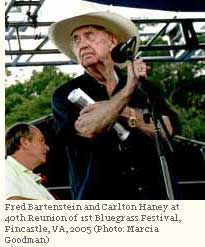 When Haney’s Labor Day festival moved to Berryville, Virginia, Fred was there again, and when Haney was called away because of his mother’s illness, Dick Freeland asked Fred to take over emcee duties. Haney remembers, "It was in Berryville, I’m sweeping the stage and a young boy came up and said ‘I’m Fred Bartenstein and I want to help you.’ And I said, ‘Alright.’ I knew just as good as anything in the world that I had a man who could do these festivals right. I handed him the book and I got back Sunday morning. But from that day on I only went on stage on Sunday. I did the story and he did everything else. I couldn’t have done it without him." When Haney’s Labor Day festival moved to Berryville, Virginia, Fred was there again, and when Haney was called away because of his mother’s illness, Dick Freeland asked Fred to take over emcee duties. Haney remembers, "It was in Berryville, I’m sweeping the stage and a young boy came up and said ‘I’m Fred Bartenstein and I want to help you.’ And I said, ‘Alright.’ I knew just as good as anything in the world that I had a man who could do these festivals right. I handed him the book and I got back Sunday morning. But from that day on I only went on stage on Sunday. I did the story and he did everything else. I couldn’t have done it without him."
During the school year, Fred was still in high school in New Jersey, and listened to bluegrass programs on WBAI and WKCR out of New York City. Fred soon met Dave Freeman, Bill Vernon, Charles Faurot and Peter Wernick, early collectors and disciples for bluegrass and old-time country music. Occasionally, Fred was able to DJ WBAI’s "Country Music" on Sunday evenings, by taking a bus from his home in the countryside of New Jersey to New York City.
During his teenage years, then, Fred was building connections between the northern and southern bluegrass scenes, moving comfortably in both worlds, and learning the music and the business of radio, promotions, and festivals. It was a split that reflected his parents’ combination of southern heritage and northern experience. It would serve him later in being able to communicate among and between these communities.
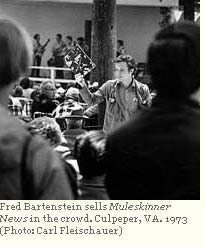
In 1969, Carlton Haney and Kathy Kaplan collected subscription money from festival-goers at Camp Springs, NC for a start-up magazine which would be dedicated to bluegrass music, Muleskinner News. Fred edited the bi-monthly, then monthly, magazine until January 1975, all while he was going to college. The March 1974 issue included a summary of the first market survey of bluegrass music. The research had appeared in full in the Journal of Country Music in the fall of 1973, included information on the demography of readers of Muleskinner News, and was a precursor of the more extensive market research done by the IBMA years later.
In 1969, Fred entered Harvard University. He was interested in urban studies, having worked in a Newark public housing project after high school, but there was also a thriving bluegrass scene in Boston: the Lilly Brothers, Don Stover, Joe Val, Bob and Grace French, and others. He became a DJ on "Hillbilly at Harvard" on WHRB, and occasionally played guitar with Don Stover and the White Oak Mountain Boys. Fred recalls, "We had a gig in Greenfield on the western edge of the state, and would leave on Friday afternoon, play Friday night till late, play Saturday night, then drive home early Sunday morning." He also played occasionally with the Lilly Brothers, Richie Brown, Jack and Alex Tottle, Steve Arkin, and Eric Levenson.
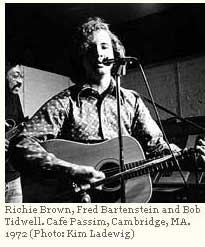
Fred co-founded, along with Nancy Talbott, the Boston Area Friends of Bluegrass and Old-Time Country Music, one of the first regional bluegrass associations. He booked Ralph Stanley, the Shenandoah Cut-Ups, Vern and Ray, Clark Kessinger, and remembers creating stickers for a Bill Monroe concert and holding a Bill Monroe look-alike snowman contest in order to publicize the event.
In 1974, Fred left Boston with a B.A. in Social Studies for Dayton, Ohio, as a procedural analyst in the police department, and then served as assistant to the city manager. His move to Ohio was influenced, just as his previous move to Boston, by the presence of a dynamic bluegrass scene. "I wouldn’t move somewhere that wasn’t a bluegrass area."
While in Dayton, he had to decide whether he was going to pursue playing bluegrass on the road as a musician or serve bluegrass in the background. He also met his future wife, Joy, who he married in 1976. Mary Jo Leet was Joy’s best friend and the Allen Brothers lived in Joy’s neighborhood. On an excursion on the riverboat the Delta Queen–playing in a band with John Hartford, Doug Dillard, and Katie Laur–he was asked by Doug Dillard to go to Europe for a tour. Fred decided to take the less visible path in bluegrass, but he remained active in many capacities including playing in Dorsey Harvey’s band for seven years, producing Katie Laur’s first album on Vetco, and two albums for Mac Wiseman on the same label, as well as both commercial and public radio programs in the Dayton region.
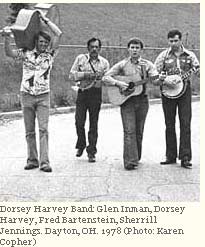
Since 2002, Fred has been involved with Bgrass, Inc., a non-profit organization formed to honor musicians who played in the Dayton to Cincinnati area of Ohio from the 1940s to the 1970s. Katie Laur formed the group and asked Fred to be on the board. He now serves as chair and works with President Tom Kopp and Miami University, which houses the collection of recordings and artifacts. Fred says, "There’s a risk that this music will be forgotten, which is a shame because this area was one of the most important areas for bluegrass. It’s where the music first moved north and evolved from the original rural sound." The organization has recently finished work on a two-hour radio special on the Osborne Brothers.
Bassist and writer, Jon Weisberger, who served on the Bgrass, Inc. board and who has also worked with Fred on IBMA committees, says of Fred, "He brings a level of professionalism to everything he does that is invaluable, but even more than that he knows the music and the people and has a real commitment to preserving the heritage and vitality of this music."
Recently, Fred has begun to delve again into demographic research by writing a paper for The Bluegrass Music Symposium, held in September of this year at Western Kentucky University. His paper on "Bluegrass Generations" defines "first," "second," and "third" generations, terms which have been loosely used in describing bluegrass artists. With the help of Mary Jo Leet and Ed Renner, he’s mapped out 11 data points on more than 500 recording musicians. Fred’s paper describes how the bluegrass torch has been passed over seven decades, what features define the successive generations, and the particular roles they have played in the evolution of bluegrass music.
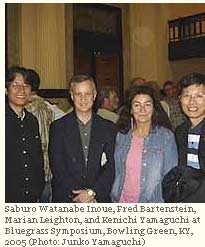
It’s a subject that interests him because it’s closely related to his own involvement with music–the passing of the torch to the next generation. Fred says, "At a very young age, I was exposed to music, and now I’m a living link. That’s what I’m driven to do: to convey, to communicate the shape, the nuance of how this music got started to people who are going to carry it on. My hope is that there is some twelve-year-old kid who will pick up the baton and run with it."
This idea of linking the generations is central to Fred’s whole approach to bluegrass music. His radio show, "Banks of the Ohio: Music From the Homeplace of Bluegrass" divides the history of the music into six segments. "Walls of Time: Sources of Songs and Styles" compares bluegrass renditions to songs that originated in other forms of music. "Dawn of the Bluegrass Era: 1936—1954" features recordings of the pioneers, many of them enshrined in the Bluegrass Hall of Honor. "Starving Out: 1955—1969" explores strategies bluegrass employed to survive in the face of rock ’n roll and changing public tastes. "The Festival Era: 1970—1989" demonstrates how today’s artists arose, encouraged by bluegrass’s gracefully aging founders. "Modern Roots: 1990-present" plays tracks from the CD era that build upon decades of tradition. "Walls of Time to Come: Modern Branches" shows how artists extend the bluegrass sound through experimentation.
Fred weaves the music and the history together to present an entertaining show that links musicians and songs across time and genres. He produces "Banks of the Ohio" as a labor of love for the International Bluegrass Music Museum in Owensboro, Kentucky, which offers the program without charge to commercial and non-commercial broadcast outlets worldwide.
Few people have been as steady in their love of, and service to, bluegrass music as Fred Bartenstein. It is not by accident that Fred has been present at key moments in the history of the music; he placed himself there because there was a need. He volunteered not as a way of placing himself in the spotlight, but as a way of making sure the spotlight shone brightly, fairly, and constantly on the music.
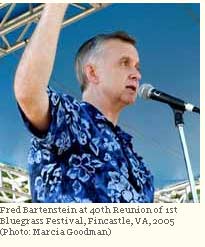
As we celebrate the 20th anniversary of IBMA, it’s right that we look at those people who performed some of its functions before IBMA. As Fred says, "There were many other people out there who were early linkers and networkers for bluegrass music: Bill Vernon, Kathy Kaplan, Doug Benson, Dave Freeman, Pat Ahrens, Dick Freeland, Faye McGinnis, Pete Kuykendall, Frank & Marty Godbey, Jean Osborn, Lance LeRoy, Doug Green, Nancy Talbott, and many, many others."
Fred is certainly among that list, and his work continues. "What we do now with email, we used to do with the telephone, mimeograph, pen, and typewriter, sharing information and imaging ways in which bluegrass could become more successful." And he hasn’t stopped thinking about how bluegrass can be more professional, more adaptable in responding to change, more diverse in its community, while at the same time preserving the heritage and power of the music. As Fred says, "We have to be flexible, but we can’t forget who we are and where we came from. That way, we can envision an exciting future for bluegrass that grows from strong roots."
Chris Stuart is a writer and songwriter based in San Diego. He is also an alumnus of Leadersip Bluegrass, class of 2004, and currenlty leads the band Chris Stuart & Backcountry.
|

